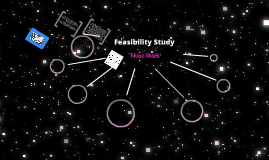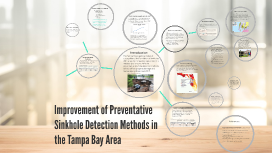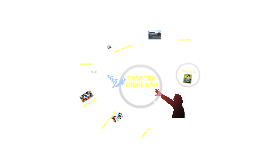Feasibility Study Presentation
Transcript: Sinkhole Detection Methods Who is responsible? Site inspections Geophysical site characterization Floor mapping Subsurface geotechnical testing Lab testing In the early 1990's, the Florida Sinkhole Research Institute, responsible for reseaching sinkholes and updating the sinkhole database, was discontinued. How many people are at risk? Since then, the Florida Geological Survey, responsible for collecting and interpreting data used to improve the understanding of Florida’s natural resources and geological hazards, has not had a committee dedictated to accurately updating the only public database on sinkholes: According to the U.S. Census projections, the Tampa Bay area population is expected to increase by 15% over the next 10 years (2020). Figure 7 Interactive land subsidence map Dissolution Sinkholes These methods are used by insurance companies only after land subsidence has been reported (Castille, Conklin, & Schmidt, 2005). Figure 6 Population Projects Tampa Bay MSA Dissolution sinkholes occur in areas where the rainwater seeps through crevices in the bedrock and dissolves the surface causing a visible depression (Galloway, Jones, & Ingebritsen, 1999). What causes sinkholes? Figure 2 Formation of Dissolution Sinkholes What are sinkholes? Sinkholes can have natural causes or human induced causes. Source: The Florida Department of Enviornmental Protection Data source: Retrieved from the U.S. Census Bureau Source: USGS This increase, will lead to even more urban development. Thus, increasing the risk of human induced sinkholes. Sinkholes are underground caverns where the ground surface has collapsed due to the erosion by acidic water of the bedrocks surrounding them (Galloway, Jones, & Ingebritsen, 1999). Three types of sinkholes are common: 1. Dissolution sinkholes 2. Cover-collapse sinkholes 3. Cover subsidence sinkholes What can be done? The Tampa Bay Resiliency Coalition Steering Commitee, responsible for addressing climate change and resiliency issues, should: Raise or request funding from the Florida Legislature to form a Sinkhole Detection and Prevention Committee. Figure 8 Tampa Sinkhole What would a dedicated commitee accomplish? Introduction Source: CBS News Ensure complete and accurate data in the land subsidence database Ensure advancement in research of preventative measures Ensure standards are put into place for preventative detection methods Increase the security of Tampa Bay Decrease risk of human injury or death Decrease insurance payout costs Cover Subsidence Sinkholes Cover subsidence sinkholes form where the surface is mainly composed of sand. The sand shifts into cavern slowly causing a depression to form (Galloway, Jones, & Ingebritsen, 1999). Tampa Bay's Geology Figure 4 Formation of Cover Subsidence Sinkholes The Tampa Bay's geology makes it susceptible to the formation of sinkholes. With a rapidly increasing population, it is necessary to ensure there are preventative sinkhole detection methods to help off-set property damage and human injury (Kromhout,2017). The Tampa Bay area is built upon limestone with a surface crust made of sand and clay. This is combination of rocks make the area highly susceptbible to the formation of sinkholes(Castille, Conklin, & Schmidt, 2005). Source: USGS Figure 5 Map of Sinkhole Occurance Figure 1 Sinkhole swallows a car in Tampa Human Induced Sinkholes Human activities such as drilling new water wells for contruction, creating artificial ponds or lakes, and withdrawing ground water for irrigation urbanization and development, may induce sinkholes. Source: CBS News Source: Florida Geological Survey Naturally Caused Sinkholes Surface water and rainwater are responsible for the natural formation of sinkholes. Heavy rain from hurricanes can accelerate erosion of the bedrock and thus the formation of sinkholes. Cover-collapse Sinkholes Cover-collapse sinkholes occur in areas, such as Tampa Bay, where the ceiling of the underground cavern in the bedrock is made up of clay (Galloway, Jones, & Ingebritsen, 1999). Figure 3 Formation of Cover-collapse Sinkholes References: Improvement of Preventative Sinkhole Detection Methods in the Tampa Bay Area Source: USGS Castille, C. M., Conklin, E. J., Schmidt, W. (2005). Geological and Geotechnical Investigation Procedures For Evaluation of the Causes of Subsidence Damage In Florida. Retrieved 2021, from http://publicfiles.dep.state.fl.us/FGS/FGS_Publications/SP/SP57GeologicalProcCausesSubsidenceDamage.pdf CBS News. (2013, March 04). 10 sinkhole facts that could save your life. Retrieved February 27, 2021, from https://www.cbsnews.com/news/10-sinkhole-facts-that-could-save-your-life/ Florida Geological Survey (2021). Subsidence Incident Reports. Retrieved February 27, 2021, from https://floridadep.gov/fgs/sinkholes/content/subsidence-incident-reports Galloway, D. L., Jones, D. R., & Ingebritsen, S. (1999). Land subsidence in the United States. Circular. doi:10.3133/cir1182 Kromhout, Clint. (2017). The Favorability of

















